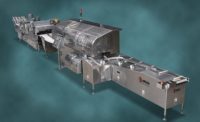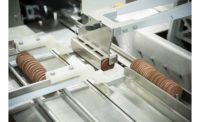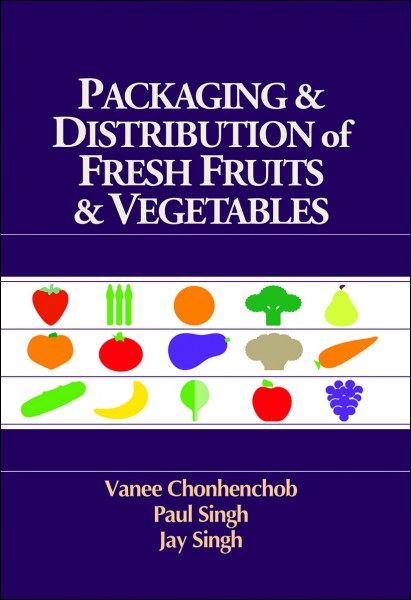On-the-go, time-pressed consumers who value freshness, portability and sustainability are continuing to drive demand for products in stand-up pouches, flexible packaging and other options with easy-to-use closures. And these consumers are willing to pay more for products in packaging that satisfies these needs.
We’re starting to see these changes across the board. “Store brands are growing and changing their packaging to meet these demands,” explains Art Malcomson, director of sales and marketing, Zip-Pak, an ITW Co., Manteno, IL. “Safeway, Target and Kroger have introduced zippers on snack and cereal products. Resealability puts private-label products in the same consumer consideration mindset as national brand-name snacks.”
Malcomson notes a number of closures are well-suited to snacks and bakery products. His company recently introduced Vector, a matrix fastener that mates to itself for easy reclosability. Inno-Lok is a patented product and method for attaching reclosable fasteners to packaging films, producing a roll of pre-zippered film. Pour & Lok is a resealable packaging solution that combines easy opening with pour-spout functionality. Slider Select features an ergonomically designed slider that enables consumers to easily open and close a flexible package, while ZIP360 features a wide opening for easy access to its contents.
“Both Pour & Lok and ZIP360 offer tactile and audible feedback, indicating to the user that the package has been securely sealed,” says Malcomson, adding that both can be incorporated into existing machinery with minor modifications.
“Consumer demand for on-the-go package styles has definitely increased the need for stand-up pouches with zipper closures,” says Christie Taraborelli, marketing manager, WeighPack Systems, Montreal. The company offers solutions for both pre-made bags and rollstock film used for a variety of bag styles, including pillow, stand-up, gusseted and quad-seal bags, with zipper closures or handles.
“We see the trend toward stand-up doy-style bags with zippers continuing to grow,” says Tom Sosnoski, product manager, VFFS, Bosch Packaging Technology Inc., New Richmond, WI. “These bags have a larger opening to access the product and offer a nice ‘billboard’ effect on the store shelf. They also tend to pour better due the shape of the bag opening.”
Sosnoski also sees more baked goods and snack foods moving to quad-seal stand-up bags. “Predominantly, we get requests for doy-style bags, but the quad-seal is growing as food producers try to differentiate their packages on the store shelf,” he explains. “Also, more customers are showing interest in tape and label re-closures, which are more efficient to apply and less expensive than zipper closures.”
According to Mitch Lindsey, technical sales director, Burford Corp., Maysville, OK, zipper and snap-style closures have reached the end of their trend because of the high cost of this type of bag and the additional cost of the packaging process. “Bakers and snack food producers are returning to previous methods of closure,” he says. “However, there is still interest in ‘tamper-evident’ packaging. To meet this demand, Burford offers the TCS-400 tape closure system and TEC-200 tamper-evident closure.”
Flexible packaging equipment
While many manufacturers continue to see increasing demand for reclosable flexible packaging, the conversation has changed significantly. “Five years ago, brand marketers were asking, ‘Can we introduce this product in a flexible resealable package?’” says Malcomson. “Today, the question has evolved to, ‘Why can’t we introduce this product in a flexible resealable package?’”
The response is that they can. “Once exclusive to the specialty beverage category, a growing number of products today are being introduced or reintroduced in flexible, resealable packaging in a broad range of consumer sectors, including bakery and snack food products,” says Malcomson.
Sosnoski notes that his company has seen growing interest in its SVI 4020 WR bagger, a flexible machine that can produce bags ranging from simple pillow packs to quad-seal and doy-style with zippers. “There is a lot of excitement around this model due to its quick changeover and flexibility,” he says, “yet, it is packed into a small footprint compared to traditional horizontal machines.”
MultiVac Inc., Kansas City, MO, recently introduced the MultiVac R 085, a small-footprint machine that represents a step up from vacuum chamber equipment to thermoforming equipment. “Bakers and snack producers can quickly achieve savings by forming their own pouches for products using rolls of film, rather than paying for pre-made pouches,” says Michael Parrish, product specialist, compact equipment, for the company. “We have customers who have been using our vacuum chamber equipment and pre-sealed vacuum pouches for years, and want to improve their packaging, while decreasing associated costs. We have introduced smaller thermoforming equipment to fill this niche.”
Continued innovation
Bakers and snack producers also are looking for packaging that is easy to open and reclose with the end consumer in mind, says Gary Ellington, western divisional sales manager, Kwik Lok Corp., Yakima, WA. “The consumer shouldn’t have to use a pair of scissors or break a fingernail trying to open a product,” he adds.
Kwik Lok recently made software updates to its high-speed 893 Ultra bag closer. “We’ve added the ability to monitor the arrival of a package and assure that a closure has advanced and the printer has received a signal to print with each package,” Ellington explains. “We’ve also added a sensor that will alert the bakery operator when it is time to mount new Kwik Loks.”
Kwik Lok, along with Markem-Imaje USA, Kennesaw, GA, recently introduced the X60 thermal transfer printer, which prints up-to-date information on Kwik Loks at speeds of more than 110 bags per minute. This feature also enhances product traceability.
These packaging innovations point to continued growth in the sector. “For now, the popularity of doy-style bags will continue to grow,” says Sosnoski, “but the next trend will be toward corner-seal bags and flex-can style bags—essentially a quad turned on its side. These innovations can provide differentiation on the retail shelf, as well as a premium look.”
Serving diverse applications will also prove key to growth. Ellington sees a trend toward more start-up businesses that deliver easy-to-prepare meal kits, healthy alternative menus for an aging population, and more ethnic flavors and foods that cross cultural lines. “Kwik Lok serves a wide range of customers—from a one-person start-up that uses hand-applied bag closures to the most highly automated bakeries in the world. Our goal is to offer bag-closure equipment that can fit in any size facility and help it grow.”











